México/10 noviembre 2016/Fuente:Batazos
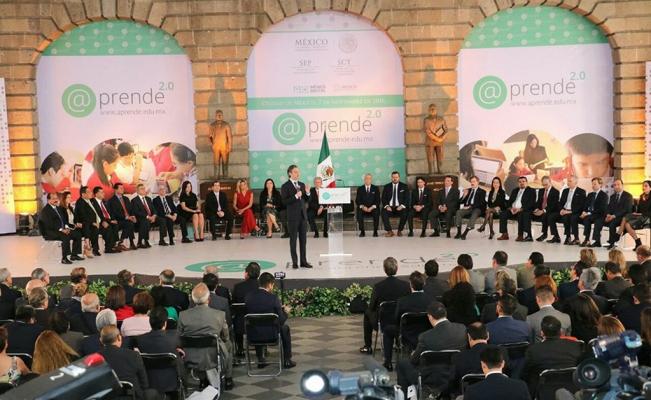
México/10 noviembre 2016/Fuente:Batazos
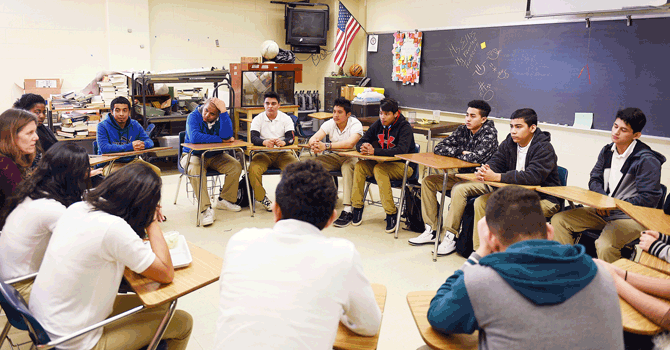
Estados Unidos/10 noviembre 2016/Fuente: La Tribuna Hispana
Desde hace 4 años varios distritos escolares en Long Island, Nueva York, han visto crecer el número de estudiantes inmigrantes —mayormente de los países centroamericanos afectados por la pobreza y la violencia—, que necesitan más recursos para poder aprender inglés y flexibilidad para cumplir con los requisitos de graduación, dijeron un grupo de panelistas que, el pasado lunes 7 de noviembre, llevaron a cabo un simposio organizado por el Distrito Escolar de Roosevelt.
Los administradores escolares presentes en el foro, donde estuvieron presentes docenas de residentes del distrito y educadores de los sistemas escolares de Nassau y Suffolk, cuestionaron la efectividad de un enfoque educativo actual, denominándola “de talla única”, porque los recién llegados necesitan una ayuda adicional para ponerse al día académicamente y superar el trauma emocional de los peligrosos viajes que realizaron en su travesía para cruzar la frontera de Estados Unidos con México.
Piden nuevas políticas educativas
“Debemos desarrollar un marco de políticas estatales, que apoye un sistema integral de vías de aprendizaje flexibles”, dijo en su discurso inaugural Betty Rosa, la Canciller de Regentes, remarcando que ella favorece el uso de “planes de aprendizaje individuales” para adaptarse a las necesidades individuales de diferentes estudiantes.
Los maestros y los padres también dijeron que se necesita más información para los familiares o tutores de los niños, quienes han venido a Estados Unidos desde el 2012, como parte de una ola migratoria de menores no acompañados, en su mayoría de El Salvador, Honduras y Guatemala. Muchos de ellos fueron reasentados con sus padres o familiares cercanos en la Isla y la mayoría eran adolescentes y no hablaban inglés cuando fueron matriculados en las escuelas, pero se espera que ellos logren los estándares de los hablantes nativos para poder graduarse.
Crear nuevas iniciativas
Rosa señaló que apoyará la creación de iniciativas para ayudar a los menores. “En lugar del Common Core, necesitamos encontrar un núcleo de resultados comunes”, dijo ella, al tiempo que abordó “el tema de la equidad y la justicia social”.
Como miembro de la junta de Regentes, que establece la política educativa a nivel estatal, Rosa ha criticado la implementación del estado de los planes educativos del Common Core, el cual ha tenido un amplio rechazo en Long Island. Ella asumió el cargo de canciller del Panel de Regentes, de 17 miembros, en abril pasado.
El simposio, para discutir “un camino para el éxito académico, social y emocional” de los estudiantes inmigrantes, trató de abrir una conversación sobre la mejor manera de responder a la migración de estos niños a la Isla. La mayor parte de ellos asisten a escuelas en comunidades donde gran parte de sus residentes son inmigrantes, dijo Marnie Hazelton, superintendente de las escuelas de Roosevelt.
Un llamado al departamento de Educación
En una sesión anterior en el simposio del lunes, los superintendentes de los distritos escolares de Mineola y Glen Cove, acordaron que les gustaría encontrar otras maneras de integrar, evaluar y medir el progreso de los estudiantes inmigrantes que llegaron en la edad de acudir a la escuela secundaria y que tienen pocas probabilidades de pasar los exámenes estandarizados. También destacaron la necesidad de más fondos para las escuelas que están haciendo frente a una afluencia de estos estudiantes.
“Le ruego al Estado que escuche”, dijo Maria Rianna, la directora de las escuelas de Glen Cove, refiriéndose al Departamento de Educación del estado. “Dennos la oportunidad de presentar propuestas de subvenciones que provean una variación en cómo proveemos servicios de ENL [Inglés como un Nuevo Idioma]… Para que nuestras fórmulas de ayuda estatal satisfagan mejor las necesidades de los estudiantes”.
Los estudiantes inmigrantes en número
Long Island es uno de las principales regiones en toda la nación donde se han reasentado los menores no acompañados, porque allí se encuentran grandes comunidades de inmigrantes centroamericanos, establecidas desde hace más de tres décadas.
Las cifras emitidas recientemente por la Oficina Federal de Reasentamiento de Refugiados, muestran que en el año fiscal que finalizó el pasado 30 de septiembre, la población de niños reasentados aumentó en un 140 por ciento en los últimos 12 meses, con 2,691 menores no acompañados que ahora viven en Nassau y Suffolk. Miles más llegaron en los últimos años.
Fuente noticia: http://www.tribunahispanausa.com/long-island/educadores-ofrecieron-propuestas-para-ayudar-los-estudiantes-inmigrantes/
Fuente imagen:http://epmghispanic.media.clients.ellingtoncms.com/img/photos/2016/02/12/inmigrantes_t670x470.gif?23a6cf1936a4889561e6226c97c290c4239edcb5
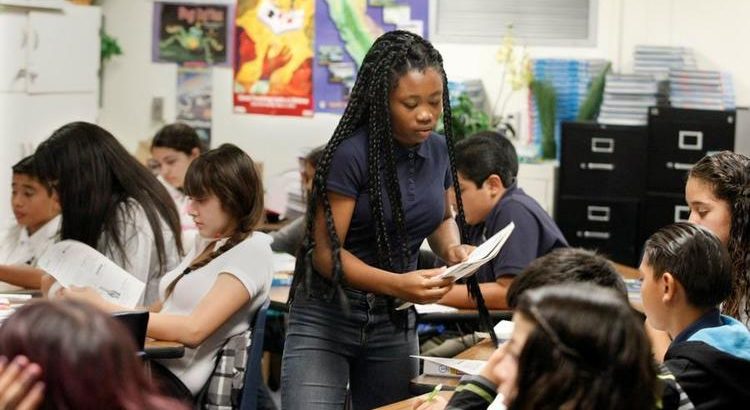
Los Ángeles / 09 de noviembre de 2016 / Por: Joy Resmovits / Fuente: http://www.hoylosangeles.com/
California cuenta con algunos de los innovadores más famosos de los Estados Unidos, sin embargo, en la materia de ciencias los resultados de las pruebas de sus estudiantes están por debajo de la media nacional, esta información de acuerdo a un nuevo informe federal.
Los resultados del estado en el examen de ciencia que periódicamente se toma a nivel nacional también fueron pobres en comparación con los de la mayoría de los otros estados, aunque los promedios de los alumnos de escuelas públicas de la mayoría de los estados no superaron la mitad del total de puntos de la prueba (300).
El informe, publicado el martes pasado, observa los resultados del examen National Assessment for Educational Progress (Evaluación Nacional de Progreso Educativo en Ciencias), tomado por los estudiantes en cuarto, octavo y doceavo grados durante el año pasado, y los compara con los resultados anteriores.
A nivel nacional, las calificaciones de los estudiantes de cuarto y octavo grado mostraron mejoras estadísticamente significativas, mientras que las puntuaciones de doceavo grado quedaron estancadas.
En California, algunos logros medidos fueron considerados estadísticamente insignificantes debido al tamaño de las muestras. Pero los estudiantes latinos de cuarto grado mostraron el mayor avance en particular.
«Vemos estos resultados como un prometedor indicador de progreso, pero nos damos cuenta de que hay mucho trabajo por hacer», señaló el secretario de educación de los Estados Unidos, John B. King Jr., acerca de los resultados nacionales. «Nos preocupa que, como país, todavía no estamos preparando a la fuerza laboral del futuro en las áreas STEM [ciencias, tecnología, ingeniería y matemáticas] que necesitamos». El científico Bill Nye se unió a King en una conferencia telefónica con los reporteros.
A nivel nacional, la puntuación promedio para estudiantes de cuarto grado subió de 150 a 154, de los 300 puntos posibles. Para octavo grado, las puntuaciones aumentaron de 152 a 154. En 2015, los estudiantes de cuarto grado de California anotaron 140, en promedio, y los estudiantes de octavo grado obtuvieron 143.
«Yo estaría preocupado. Obviamente el estado puede hacerlo mejor, porque casi todos los otros estados han tenido mejores resultados», señaló Tom Loveless, investigador principal de Brookings Institution, en Sacramento. “Y no creo que esto se deba a desafíos demográficos».
La Evaluación Nacional de Progreso Educativo (NAEP, por sus siglas en inglés), administrada por la rama de investigación del Departamento de Educación de los Estados Unidos, pretende ser rigurosa. Es la única de esas pruebas que permite la comparación estado por estado. Los estudiantes responden preguntas de ciencias físicas, ciencias de la Tierra y el espacio, o ciencias de la vida.
De todos los grupos étnicos en California solamente los estudiantes latinos lograron progresos significativos; los puntajes de cuarto grado subieron de 121 a 128.
En California, un gran número de alumnos viven en la pobreza y otros son aprendices del inglés; las clasificaciones de las puntuaciones reflejan a menudo tal demografía. Pero un estudio anterior de pruebas en otros temas descubrió que los puntajes de California siguen bajos, aun cuando esos factores se contabilizan.
Por otra parte, el estado está en proceso de implementar un nuevo conjunto de expectativas para la enseñanza de las ciencias, conocido como Next Generation Science Standards (estándares de ciencia para la siguiente generación). La próxima semana, la Junta Estatal de Educación adoptará un marco de plan de estudios alineado con los estándares, que enfatiza la investigación científica y la creación de continuidad entre los diferentes temas.
En la próxima primavera las nuevas pruebas estatales -alineadas con los estándares- se pondrán en marcha en un programa piloto. Hasta que estos exámenes sean totalmente operativos y los resultados estén disponibles es difícil saber cómo encajan los resultados de la evaluación nacional en un cuadro más amplio de enseñanza de las ciencias en California.
Debido a que los distritos todavía no han aplicado plenamente las nuevas normas estatales, Jessica Sawko, directora ejecutivo de la Asociación de Maestros de Ciencias de California afirmó que no ha dado mucho valor a los puntajes obtenidos en las pruebas NAEP. Después de todo, dijo, éstas pueden haber medido material que las escuelas de California planean enseñar pero que aún no lo hacen.
Si desea leer la nota en inglés, haga clic aquí.
Traducción: Diana Cervantes
Fuente noticia: http://www.hoylosangeles.com/latimesespanol/hoyla-estudiantes-de-ciencia-en-california-estan-muy-por-debajo-del-promedio-nacional-20161107-story.html

Por: Tom Engelhardt
Billones de palabras, esa cara, esos gestos, los interminables insultos, las mujeres maltratadas y los correos electrónicos, el espectáculo que dura las 24 horas de los siete días de cada semana que muestra todo esto… Pase lo que pase el día de las elecciones, admitamos una realidad: en este país, hemos entrado en una nueva era política. Solo que no nos hemos dado cuenta del todo. De verdad que no.
Olvidaos de Donald Trump.
¡Caramba! ¿Por qué escribí esto? ¿Cómo podría alguien olvidarse del primer candidato presidencial de nuestra historia que anticipó que no está dispuesto a aceptar el resultado de las elecciones? (en 1860, hasta los sureños aceptaron la elección de Abraham Lincoln antes de intentar separarse de la Unión). ¿Quién podría olvidar al hombre que denunció que con la ley actual las mujeres podían abortar el mismo día del nacimiento o apenas un día antes? ¿Quién podría olvidar al hombre que aseguró ante una audiencia de unos 72 millones de estadounidenses que no conocía a las mujeres que le acusaban de agresión sexual y maltrato, entre ellas la periodista de la revista Peopleque lo entrevistaba? ¿Quién podría olvidar al candidato que se jactaba mes tras mes de los resultados positivos de los sondeos en los mítines políticos y en twits antes de que (cuando esos mismos sondeos se volvieron contra él) se descubriera que todos ellos estaban amañados?
Piénsese lo que se piense de Donald, ¿quién en este mundo –y con esto quiero decir todo el mundo, incluyendo a los iraníes– podría olvidarse de él o de las elecciones por las que apostó tan ominosamente? Sin embargo, cuando pensemos en él no lo convirtamos en la causa de la disfunción política de Estados Unidos. Él no es más que el síntoma –extravagante, trastornado e inquietante– de la transformación del sistema político de Estados Unidos.
Admitámoslo, Donald es un “político” que no tiene igual, incluso entre sus colegas de la emergente derecha nacionalista y movimientos anti-todo del ámbito global. Él hace que la francesa Marine Le Pen parezca la racionalidad personificada y que el presidente de Filipinas, Rodrigo Duterte, se asemeje a un experto táctico de nuestra época. Pero lo que de verdad convierte a Donald Trump y su carrera por la presidencia en algo fascinante y desconcertante es que no estamos hablando solo de la presidencia de un país: Estados Unidos es el país. El país que, en términos del despliegue de sus fuerzas armadas y su poder económico y cultural para influir en el funcionamiento de todo en prácticamente cualquier sitio, sigue siendo la gran nación imperial del planeta Tierra. Aun así, sobre la base de lo acontecido en este insólito año de campaña electoral, cuesta mucho no pensar que hay algo –y no se trata solo de Donald– incómodamente equivocado en el contexto estadounidense.
La generación de la Segunda Guerra Mundial en 2016
Algunas veces, cuando me dejo llevar por mis fantasías (me pasó mientras miraba el último debate presidencial), monto un milagro privado y traigo –de regreso de la muerte– a mis padres para que observen nuestro mundo estadounidense. Con ellos en la sala, trato de imaginar la incredulidad que muchos de la generación de quienes vivieron la Segunda Guerra Mundial con toda seguridad sentirían ante nuestro tiempo presente. Por supuesto, ellos debieron soportar una devastadora depresión económica, a años luz de cuanto hemos experimentado en la gran recesión de 2007-2008, como también una conflagración mundial de una magnitud como nunca se había experimentado, y –aparte de una guerra nuclear– es improbable que vuelva a suceder.
A pesar de esto, no dudo que nuestro mundo les dejaría boquiabiertos, sobre todo el particular caos con el que convivimos. Para empezar, en el ámbito global, tanto mi madre (que murió en 1977) como mi padre (que falleció en 1983) vivieron varias décadas de la era nuclear, la era de los más grandes –para quienes querían un mundo mejor– logros de la humanidad. Después de todo, por primera vez en la historia, los seres humanos tomamos el Apocalipsis de las manos de dios (o de los dioses) –donde había estado durante miles de años– y nos apropiamos de él. Sin embargo, lo que no llegaron a vivir fue, potencialmente, el segundo rompimiento de contrato –el cambio climático–, que ya está trastornando el planeta y amenazándolo con un Apocalipsis en cámara lenta del que no hay precedentes.
Ciertamente, las armas nucleares no fueron utilizadas hasta el 9 de agosto de 1945, aunque se diseminaron por los arsenales de numerosos países; el cambio climático será visto como la versión paso de tortuga de la guerra nuclear; no olvidéis que la humanidad continúa bombeando gases de efecto invernadero en la atmósfera en volúmenes siempre cercanos al récord. Imagino el asombro de mis padres si supieran que el tema más peligroso y maldito en la Tierra no mereció una sola pregunta –por no hablar de una respuesta– en los tres debates presidenciales de 2016; las cuatro horas y media de acusaciones, insultos e interrupciones que acaban de pasar. Ni un moderador, evidentemente, tampoco un votante indeciso (en el segundo debate en el ayuntamiento), ni un candidato presidencial –cada uno de ellos preparado para cambiar de tema en un momento de apuro con preguntas sobre agresiones sexuales, correos electrónicos o cualquier otra cosa– pensó que eso mereciese la menor atención. En resumen, era un problema demasiado grande para discutirlo, uno cuya existencia Donald Trump (como cualquier otro republicano) niega, o mejor aún, en su caso, rotula como un “engaño” y solo atribuye a una conspiración china para hundir a Estados Unidos.
Otro tanto de locura (y de estupidez) cuando se trata de la cuestión más vasta de todas. En una algo más modesta escala, mi madre y mi padre no habrían reconocido como estadounidense nuestro ámbito político de hoy, y no solo debido a Donald Trump. Se hubieran quedado pasmados por el dinero que se vierte en él: por lo menos 6.600 millones de dólares en estas elecciones según la última estimación; más del 10 por ciento del cual provino de solo 100 familias. Se habrían sorprendido por nuestras elecciones del 1 por ciento; por nuestra nueva Era Dorada; por un famoso multimillonario de la televisión que se presenta como un «populista» y tiene el apoyo de la gente blanca de clase trabajadora que antes era demócrata y que ahora se siente atraída por personas como Trump y su marca de capitalismo de casino, fraudes y espectáculo; por todos esos otros multimillonarios que derraman dinero en las arcas del Partido Republicano para crear un Congreso manipulable que responda a sus pujas obstruccionistas; y por las enormes cantidades de dinero que en estos días se puede “invertir” en muestro sistema político de una forma perfectamente legal. Y ni siquiera he mencionado a la Otra Candidata, que dedicó todo agosto a la verdadera “campaña electoral”, codeándose no con estadounidenses de a pie sino con millonarios y multimillonarios (y una colección de celebridades) para llenar su fenomenal “arcón de guerra”.
Yo debería haber aspirado profundamente y explicado a mis padres que en el Estados Unidos del siglo XXI, por decisión del Tribunal Supremo, el dinero se ha convertido en el equivalente del discurso, aunque sea cualquier cosa menos “libre”. Y no olvidemos esa otra atracción financiera en una elección estadounidense de estos días: las noticias televisadas, por no hablar de los demás medios. ¿Cómo podría siquiera empezar a esbozar eso a mis padres –para quienes las elecciones presidenciales eran un acotado acontecimiento otoñal– la naturaleza extravagante de una temporada de elecciones que se inicia con la especulación mediática justo cuando la temporada anterior está acabando y desde entonces continúa más o menos sin interrupción? ¿O el espectáculo de los comentaristas discutiendo las 24 horas de los siete días de la semana sobre nada que no sean las elecciones en la televisión por cable durante al año entero, o los miles de millones en anuncios que alimentan esta interminable Súper Copa de campañas, llenando las arcas de los propietarios de los cables y las redes de noticias?
Nosotros hemos crecido extrañamente habituados a todo esto, pero mi madre y mi padre sin duda pensarían que estaban en otro país -y eso hubiera ocurrido incluso antes de conocer el sistema político actual, cuyo estrafalario representante es Donald Trump.
De cualquier modo, ¿qué planeta es este?
Me gustaría haber conservado un texto de educación cívica de la escuela secundaria. Si tienes cierta edad, lo recordarás: aquel en que un marciano pone pie en Main Street, Estados Unidos, para escuchar una conferencia sobre las glorias de la democracia estadounidense y la cuidadosamente construida, comprobada y equilibrada división de poderes de nuestros órganos de gobierno. Estoy seguro de que el conocimiento de este sistema cambió la vida en Marte para mejor, aunque en tiempos de mis padres ya hubiese algo de fantasía en este rincón de la Tierra. Después de todo, el presidente republicano Dwight D. Eisenhower –mis padres votaron al demócrata Adlai Stevenson– fue quien, en 1961, en su discurso de despedida llamó la atención de los estadounidenses por primera vez sobre “la desastrosa posibilidad de conceder poder a quien no lo merece” y sobre “el complejo militar-industrial”.
Es cierto; todo eso ya estaba cambiando en aquellos días y, aun en tiempos de paz, el país estaba convirtiéndose en una maquinaria de guerra de un tamaño sin precedentes en la historia. Aun así, 30 extraños años después de la muerte de mi padre, observando el panorama estadounidense, es posible que mis padres se creyeran en Marte. Sin duda se preguntarían qué le podría haber pasado al país que ellos conocían. Después de todo, gracias a las tácticas de tierra arrasada del Partido Republicano en estos últimos años en la bipolar Washington, el Congreso, esa colección de supuestos representantes del pueblo (hoy, un grupo de bien pagados y mejor financiados representantes de los intereses especiales del país en una capital plagada de grupos de presión corporativos), ya rara vez funciona. Carente de relevancia, merodea entre los pórticos del Capitolio. Por ejemplo, hace poco tiempo. John McCain (en general considerado un senador republicano relativamente “moderado”) sugirió (antes de dar un paso atrás en sus comentarios) que si Hillary Clinton fuera elegida para la presidencia, sus compañeros senadores republicanos podrían decidir anticipadamente no confirmar cualquier nominación que ella hiciera para el Tribunal Supremo mientras estuviese en el cargo. Esto, por supuesto, significaría que un tribunal, que ahora parece ser un equipo permanente de ocho miembros, encogería en consecuencia. Los comentarios de McCain que alguna vez habían conmocionado profundamente a Estados Unidos, apenas provocaron una marejadilla de incomodidad y protesta.
En mi paseo por este nuevo mundo, yo podría comenzar señalando a mi madre y mi padre que Estados Unidos está hoy en permanente estado de guerra; en este momento está operando en por lo menos seis países del Gran Oriente Medio y África. Todos estos conflictos armados son esencialmente presidenciales; el Congreso ya no tiene un papel real en ellos (como no sea para soltar el dinero que haga falta y batir el parche para apoyarlos). Cuando se trata de asuntos de guerra, que alguna vez eran controlados y contrapesados por la Constitución, el poder ejecutivo está solo.
De ningún modo pretendería que mis padres se limitaran a observar qué sucede en el extranjero. La militarización de Estados Unidos se ha realizado a ritmo acelerado y de una forma que –no tengo la menor duda– los horrorizaría. Por ejemplo, podría llevar a mis padres a la Gran Estación Central, cerca del centro de Manhattan, el barrio donde ellos vivían y sigue siendo el mío; cualquiera que fuese el día de la semana, verían algo inconcebible en otros tiempos: soldados de guardia con armamento de guerra y uniforme de camuflaje. Yo podría comentarles que, en mi estación de metro, vi varias veces un grupo de agentes de la unidad antiterrorista de la policía de Nueva York que muy bien podría tomarse por un grupo de operaciones especiales del ejército, con sus fusiles de asalto, pero ya nadie se detiene para mirarlos con la boca abierta. Podría agregar que los cuerpos policiales de todo el país se parecen más cada día a unidades militares y son pertrechados directamente por el Pentágono con armamento y equipo igual al utilizado en los lejanos campos de batalla de Estados Unidos, incluyendo vehículos blindados de distinto tipo. También podría mencionar que los drones militares de vigilancia, los precursores de la futura guerra robótica (salidos, para mis padres, de las novelas infantiles de ciencia ficción que yo acostumbraba leer), surcan ahora regularmente los cielos de Estados Unidos; que dispositivos de vigilancia de última generación diseñados para operar en remotas zonas de guerra, hoy en día son utilizados por la policía en el ámbito nacional; y que, a pesar de que el asesinato por razones políticas fue oficialmente prohibido en los años setenta del pasado siglo, después del Watergate, en estos tiempos el presidente está al mando de una formidable fuerza aérea de drones operada por la CIA que se ocupa regularmente de tales asesinatos –de los que no se salvan ni los ciudadanos estadounidenses– en grandes zonas del planeta, sin que sea necesario el ‘visto bueno’ de nadie fuera de la Casa Blanca, tampoco de los tribunales. Podría mencionar que quien era presidente en tiempos de mis padres comandó un ejército secreto de modestas proporciones –los paramilitares de la CIA–; en estos momentos, el presidente es el jefe de una fuerza armada secreta –el Comando de Operaciones Especiales (SOC, por sus siglas en inglés)– formada por 70.000 soldados de elite ocultos dentro del ámbito mayor de las fuerzas armadas de Estados Unidos. En el SOC hay equipos de elite preparados para ser desplegados y realizar misiones de tipo ‘comando’ en cualquier sitio del mundo.
Yo podría señalar que en el siglo XXI, el espionaje estadounidense ha erigido un estado de vigilancia de ámbito global que habría avergonzado a las potencias totalitarias del siglo precedente. Todos los ciudadanos de Estados Unidos –absolutamente todos– están en la mira de este estado de vigilancia; nuestros correos electrónicos (algo desconocido por mis padres) son recogidos por millones, nuestras llamadas telefónicas están a disposición de este estado. En resumen, que la intimidad ha sido declarada anti-estadounidense. También podría observar que, sobre la base de un día aciago [el 11-S] y de lo que en última instancia es la más modesta de las amenazas que se ciernen sobre los estadounidenses, un solo temor –al terror islamista– ha sido el pretexto para la puesta en marcha del estado de la seguridad nacional ya existente hasta transformarse en una construcción de proporciones poco más o menos increíbles a la que se ha dotado de unos poderes que en otros tiempos eran inimaginables y financiada de una manera que dejaría atónito a cualquiera (no solo a los visitantes del pasado estadounidense) y hasta llegar a ser el cuarto poder del Gobierno de Estados Unidos sin haber sido debatido ni votado previamente.
Poco de lo que hace –y hace mucho– está abierto al escrutinio público. Por su propia “seguridad”, “el Pueblo”, no debe saber nada de su funcionamiento (excepto lo que ese poder quiera que se sepa). Mientras tanto, un claustrofóbico secretismo se ha propagado por importantes partes del Estado. En 2011, el gobierno de Estados Unidos declaró secretos 92 millones de documentos, y desde entonces las cosas no parecen haber mejorado. Además, el estado de la seguridad nacional ha estado elaborando un cuerpo de “legislación secreta” –en la que se incluyen normas, regulaciones e interpretaciones de leyes existentes, todo ello debidamente clasificado– que permanece oculto al público y, en algunos casos, hasta a las comisiones de control del Congreso.
En otras palabras, los estadounidenses saben cada día menos de lo que sus gobernantes hacen en su nombre, tanto en el ámbito nacional como en el internacional.
Yo podría sugerir a mis padres que solo imaginen que en estos años la Constitución de Estados Unidos esta en un proceso de permanente reescritura y enmienda realizado con total secretismo y entre bambalinas, con poco más que un gesto de cabeza a “Nosotros, el Pueblo”*. De este modo, al mismo tiempo que nuestras elecciones se transforman en un elaborado espectáculo, la democracia ha sido vaciada de contenido y desechada en todo salvo el nombre; ese nombre es –no cabe ninguna duda– Donald Trump.
Considerad esta nota, entonces, una versión abreviada de cómo describiría yo a mis asombrados padres este nuevo mundo estadounidense.
Estados Unidos, un estado de la seguridad nacional
De nada de esto es responsable Donald Trump. En los años en que el nuevo sistema estadounidense se estaba desarrollando, él estaba echando gente en la televisión. Por supuesto, podéis verle como el muchacho de un cartel en el que se muestra un Estados Unidos donde el espectáculo, los famosos, la clase dorada del 1 por ciento y el estado de la seguridad nacional se combinan en un bebedizo narcisista y autorreferencial de extraordinaria toxicidad.
Ya sea que Hillary Clinton sea electa presidente o que el electo sea Donald Trump, hay una cosa incuestionable: la vasta construcción que es el estado de la seguridad nacional, con su 17 agencias de inteligencia y unas formidables fuerzas armadas imperiales, continuará creciendo y expandiendo su poderío en nuestro mundo estadounidense. Ambos candidatos han jurado volcar todavía más dinero en esas fuerzas armadas y el aparato de espionaje y Seguridad Interior que les acompañan. Por supuesto, nada de esto tiene algo que ver con la democracia en Estados Unidos tal como una vez fue imaginada.
Tal vez algún día, al igual que mis padres, “yo” sea llamado del más allá por alguno de mis hijos para ver con espanto y horror el mundo de esos días. Mucho tiempo después de que una inimaginable presidencia de Donald Trump o de que un mucho menos imaginable mandato de Hillary Clinton sean un párrafo de un maldito y a medias olvidado capítulo de nuestra historia, yo me pregunto si en ese momento eso “me” sorprendería o “me” desconcertaría. En 2045, ¿con qué país y con qué planeta “me” enfrentaría?
* We the People son las palabras con que comienza la Constitución de Estados Unidos, que desde 1789 es la ley suprema de esta nación. (N. del T.)
Tom Engelhardt es cofundador del American Empire Project, autor de The United States of Fear y de una historia de la Guerra Fría, The End of Victory Culture. Forma parte del cuerpo docente del Nation Institute y es administrador de TomDispatch.com. Su libro más reciente es Shadow Government: Surveillance, Secret Wars, and a Global Security State in a Single-Superpower World.
* Traduccido de ingles para Rebelión de Carlo Riba Garcia
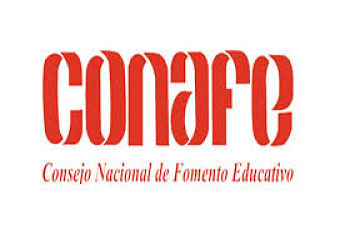
México / www.noticias.terra.com.mx / 9 de Noviembre de 2016.
El modelo de Aprendizaje con Base en la Colaboración y el Diálogo ABCD del Consejo Nacional de Fomento Educativo (Conafe) será exportado a escuelas de educación básica en California, Estados Unidos y a Chile, informó la directora de Educación Comunitaria e Inclusión Social de esa institución, Lilia Dalila López Salmorán.
Resaltó que el Conafe firmó un convenio de colaboración con la Organización Aprender con Interés de la Universidad de Berkeley y la Fundación Educación 2020 de Chile para analizar y aplicar el modelo del organismo mexicano en sus países.
La funcionaria explicó que el interés que ha despertado el ABCD en el mundo es porque la propuesta del modelo de Aprendizaje con Base en la Colaboración y el Diálogo ABCD cambió la manera de enseñar.
Y es que, puntualizó, «nos muestra qué debe cambiar, no sólo en los planes y programas, sino todas las otras partes del modelo educativo, materiales, forma de capacitación y las estrategias de supervisión, asesoría y seguimiento del aprendizaje».
Los países que antes eran referente de la evolución educativa en el mundo, dijo, han dejado de serlo, porque en esas naciones, antes ejemplos a seguir, se dedicaron a aspectos externos al aprendizaje como el financiamiento, aumento de los recursos y presupuesto, mejoramiento de la infraestructura.
Algunos otros países, continuó, modificaron los contenidos de sus programas, pero no cambian la manera de enseñar, no varió la relación del alumno con el maestro, «nosotros en el Conafe cambiamos la forma de eso precisamente, el corazón de la enseñanza que es la relación del maestro y el alumno, la manera de enseñar, de que los niños aprendan lo que les gusta y sirve».
Organizaciones internacionales como el Fondo de las Naciones Unidas para la Infancia (UNICEF), y la Organización de las Naciones Unidas para la Educación, la Ciencia y la Cultura (UNESCO) vendrá a México a «vivir la experiencia del modelo ABCD de aprender a aprender, en campo, en la escuela, de estar en una tutoría de capacitación».
Por su parte la presidenta de la Fundación 2020, Mirentzu Anaya Ottone, se dijo sorprendida de los avances y alcance que tiene el modelo ABCD del Conafe en la educación, «evoluciona, revoluciona las estrategias de enseñanza, cambia la naturaleza del aprendizaje y remodela la forma de enseñar. Una niña de 12 años en una escuela del Conafe me hizo comprender porque quiero aprender lo que aprendo».
La intención de la organización educativa chilena es «aplicarlo este año y parte de 2017 en algunas escuelas como modelo piloto, en siete colegios, y llevarlo lo más pronto posible en todo el sistema educativo chileno. Conafe ya lo hace en más de 30 mil escuelas de educación básica en México eso es más que todo el sistema educativo de mi país», apuntó.
Fuente:https://noticias.terra.com.mx/mexico/chile-y-estados-unidos-llevaran-modelo-mexicano-abcd-a-sus-escuelas,58cc5d35f6b6de78595eead2167b0175fw5j3tik.html
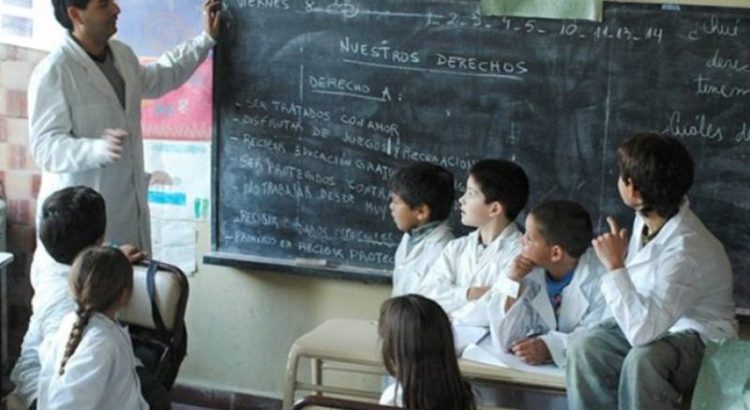
Por: Fabián Banga.
Los datos que se recogen de estos procesos no son exactos, no muestran el estado de la población estudiantil. Son un gasto innecesario y una forma de opresión de las escuelas imponiendo estándares que son irracionales y no les permite a los/as maestro/as dedicarse a lo que en verdad tienen que hacer. Son profundamente costosos, no parte de la educación de vanguardia. Algo que en lo personal evito que mi hija sufra.
Requieren demasiada preparación por parte de los estudiantes para los exámenes y pone el énfasis en una parte del proceso educativo que no es el primordial, el de evaluación. El proceso educativo es exactamente eso, un proceso, no una finalidad o una meta. Todos aquel que ha estado en la educación por algún tiempo (algunos de nosotros por mucho más) sabemos que el verdadero proceso educativo y trasformador no se generan en los exámenes, sino en el proceso y convivencia. Sí mi finalidad es, por ejemplo, enseñarles a mis estudiantes a producir textos críticos, el énfasis no está en el final de este proceso sino en el proceso mismo. Porque estos procesos no se terminan nunca.
La evaluación no es la finalidad del proceso educativo, y se aplica no en un examen final, sino en el proceso mismo del aprendizaje, en el constante evaluar de los objetivos que se van generando y adaptando. Porque la evaluación nunca da un resultado exacto. Lo primero que se aprende cuando uno llega al campo de la educación es desconfiar de los exámenes.
El colmo de los exámenes como finalidad son los exámenes estandarizados. Los exámenes estandarizados no tienen ningún valor porque no pueden analizar resultados de educandos en contextos y con recursos diferentes. Es decir, los resultados de los exámenes son inexactos. Lo que anulan la finalidad primera del proyecto.
Para ampliar este problema, hay que entender que no se puede pedir el mismo resultado a un chico que sufre de problemas y carencias, que a un chico que vive en una casa con muchos más recursos educativos y económicos. Esto hace que el proceso sea discriminativo y hasta ilegal.
Estos procesos son el primer paso hacia una comunidad educativa donde se es premiada aquella escuela que tiene éxito y castigada aquella que no lo tiene. Este proceso genera un circulo viciosos en el que las escuelas que menos tienen más pierden y aquellas que más tienen acentúan su ganancia. Porque somos todos iguales, pero no rendimos de la misma manera en condiciones diferentes.
Aprender se parece mucho a un programa que instauró George W. Bush en los EEUU y que fue un desastre: No Child Left Behind Act de 2001 (NCLB). Este programa produjo una generación desesperada por las notas que no disfruta del proceso analítico de la educación. Una generación que prefiere exámenes con preguntas del tipo verdadero o falso y que si le preguntas como se siente como ciudadano de este país no sabe que responder. El desastre de NCLB ha sido ampliamente documentado y recientes libros ofrecen estudios sobre el tema, entre ellos Schooling Beyond Measure and Other Unorthodox Essays about Education de Alfie Kohn (Heinemann, 2015)
Las élites en los Estados Unidos evitan el drama de No Child Left Behind = Aprender enviando a sus hijos a escuelas privadas que generan sus propios currículos y que no necesitan responderle estos caprichos al estado.
No veo que sea un problema copiar experiencias que han sido exitosas. Pero es lamentable copiar aquellas que no lo son. Más que nada si se sabe de los orígenes de estos movimientos. Todas estas teorías relacionadas con evaluaciones compulsivas han sido siempre difundidas y apoyadas por poderes económicos que lucran con la venta de material curricular en el área educativa. Es un negocio de billones de dólares. Ése sería el tema que hay que evaluar.
Fuente:https://diarionco.net/nacional/el-programa-aprender-es-copia-de-una-idea-que-ya-fracaso-en-otras-partes-del-mundo/
Imagen:https://i2.wp.com/diarionco.net/wp-content/uploads/2016/10/escuela-pc3bablica.jpg?resize=696%2C493&ssl=1.
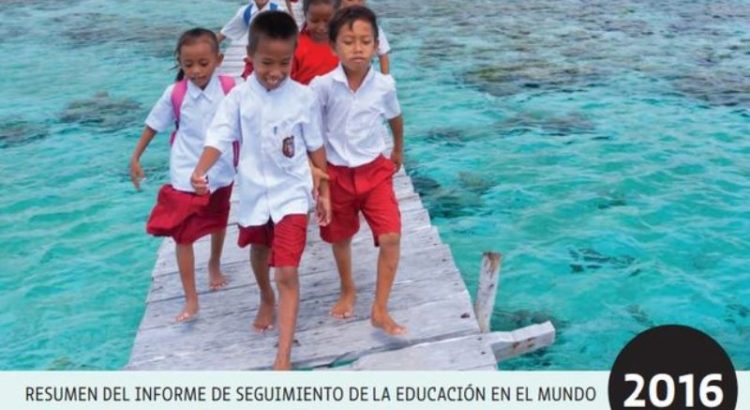
América del Norte/Estados Unidos/08.11.2016/Autor: Catherine Perea/Fuente:http://www.telemetro.com/
El nuevo informe de la Unesco, titulado “ La educación al servicio de los pueblos y el planeta”, pone en relieve las posibilidades que ofrece la educación para impulsar el progreso hacia todos los objetivos mundiales fijados en la nueva agenda 2030 para el Desarrollo Sostenible (ODS).
El documento evidencia además que la educación deberá pasar por una profunda transformación para hacer realidad ese potencial y dar respuesta a los problemas que afrontan hoy la humanidad y el planeta.
“ Es imperioso lograr avances más sustanciales en el terreno educativo. De mantenerse las tendencias actuales, en América Latina y el Caribe la universalización de la enseñanza primaria no sería una realidad hasta el 2024, la terminación universal del primer ciclo de secundaria lo sería en 2066; y la del segundo ciclo de secundaria quedaría para 2095” señala un comunicado.
Esa situación dejaría a la región con un retraso de 65 años con respecto al limite marcado para el cumplimiento de los ODS.
Por otro lado, el informe señala que los sistemas educativos deben prestar más atención a los problemas ambientales. “ En Brasil, Argentina, Uruguay y México, más del 60 % de los estudiantes de más de 15 años apenas tienen conocimientos elementales de ls temas de medio ambiente”.
El viceministro de Educación, Carlos Staff quien estuvo presente en el evento dijo que es necesario crear una cultura de evaluación de la educación para alcanzar los logros y fortalecer las debilidades. » Estamos tratando de incluir una cultura de evaluación para saber donde están las debilidades y trabajar juntos como país, este informe es para saber que estamos haciendo bien y que hacemos mal».
Staff aseguró que en el informe global, Panamá está en buena posición, sin embargo el problema redica en que » a nivel medio solo 6 de cada 10 estudiantes culmina la etapa, esa es la información que tenemos que presentar para ver donde tenemos que hacer los esfuerzos».
Los resultados del documento exhortan a los gobiernos a que empiecen a tomar como un tema serio las desigualdades educativas y hagan lo necesario para detectarlas obteniendo información derecta de las familias. El informe recalca además que los nuevos planes mundiales exigen de los ministros de educación y otros interlocutores de los círculos educativos trabajen en colaboración con otros sectores.
Fuente:
http://www.telemetro.com/nacionales/Informe-Educacion-Mundo-progreso-educacion_0_962604125.html
Imagen:
http://d1vmfp3l3lxrif.cloudfront.net/blogs/alexsclicks/Informe-Educacion-Mundo-educacion-FotoUnesco_MEDIMA20161014_0135_31.jpg